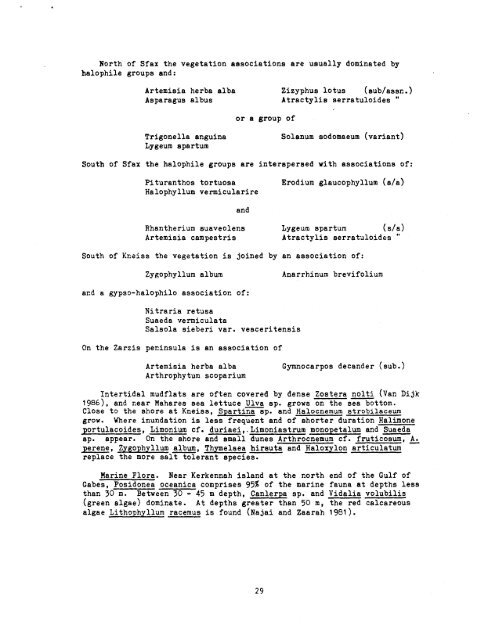biological diversity and tropical forests in tunisia - PART
biological diversity and tropical forests in tunisia - PART
biological diversity and tropical forests in tunisia - PART
Create successful ePaper yourself
Turn your PDF publications into a flip-book with our unique Google optimized e-Paper software.
North.of Sfax the vegetation associations are ueually dom<strong>in</strong>ated by<br />
halophile groups <strong>and</strong> :<br />
Artemisia herba alba Zizyphus lotus (sub/assn .)<br />
Asparagus albus Atractylie serratuloides "<br />
Trigonella angu<strong>in</strong>a<br />
Lygeum spartum<br />
or a group of<br />
Solanum sodomaeum (variant)<br />
South of Sfax the halophile groups are <strong>in</strong>terspersed with associations of:<br />
Pituranthos tortuosa Erodium glaucophyllum (da)<br />
Halophyllum vermicularire<br />
<strong>and</strong><br />
Rhantherium suaveolens Lygeum spartum (~/8)<br />
Artemisia campestris Atractylis serratuloidas "<br />
South of Kceiss the vegetation is jo<strong>in</strong>ed by an association of:<br />
Zygophyllum album Anarrh<strong>in</strong>um brevifolium<br />
acd a gypso-halophilo association of:<br />
Nitraria retusa<br />
Suaeda vermiculata<br />
Salsola sieberi var. vesceritensis<br />
On the Zarzis pen<strong>in</strong>sula is an association of<br />
Artemisia herba alba Gymnocarpos dec<strong>and</strong>er (sub.)<br />
Arthrophytum scoparium<br />
Intertidal mudflats are often covered by dense Zostera nolti (van Dijk<br />
1986), <strong>and</strong> cear Mahares sea lettuce sp. grows on the sea bottom.<br />
Close to the shore at Kneiss, Spart<strong>in</strong>a sp. <strong>and</strong> Halocnemum strobilaceum<br />
grow. Where <strong>in</strong>undation is less frequent <strong>and</strong> of shorter duration Halimone<br />
portulacoides, Limonium cf. , . Limoniastrum rnonope talum <strong>and</strong> Suaeda<br />
sp. appear. On the shore <strong>and</strong> small dunes Arthrocnemum cf. fruticosum,<br />
perene, Zygophyllum album, Thmelaea hirsuta <strong>and</strong> Haloxylon articulatum<br />
replace the more salt tolerant species.<br />
Mar<strong>in</strong>e Flora. Near Kerkennah isl<strong>and</strong> at the north end of the Gulf of<br />
Gabes, Posidonea oceanica comprises 95% of the mar<strong>in</strong>e fauna at depths less<br />
than 30 m. Between 30 - 45 m depth, Canlerpa sp. <strong>and</strong> Vidalia volubilis<br />
(green algae) dom<strong>in</strong>ate. At depths greater than 50 m, the red calcareous<br />
algae Lithophyllum racemus is found (~ajai <strong>and</strong> Zaarah 1981 ).

















